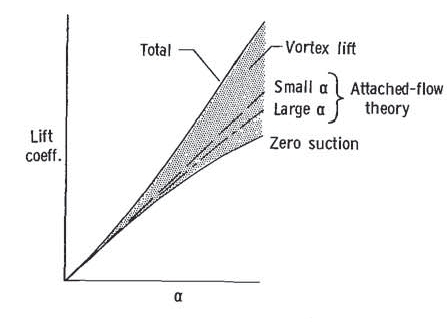The vortex lift is the method by which highly swept wings (like delta wings) produce lift at high angles of attack.
In the case of wings having sharp, highly swept leading edges like delta wings, the leading-edge separation vortex phenomenon occurs at subsonic speeds. However, the separation does not destroy the lift as in the case of low sweep wings; instead, it forms two vortices which are (nearly) parallel to the wing edges.

Vortices over a delta wing with a sweep angle of 70°, Separation in three-dimensional steady flow, ONERA
In case of Concorde, the vortices look like this:

Vortices over the Concorde wing, Separation in three-dimensional steady flow, ONERA
A cross-section of the vortices looks like this:

Flow above the Concorde Wing, Separation in three-dimensional steady flow, ONERA
Unlike the (bound) vortex of the conventional wing, these are real in the sense that they represent an actual mass of air rotating at high speed compared to the air in front of the wing.
The vortices form 'vortex sheets' along the wing. Air is sucked into the vortex sheets and accelerated downward. As the airspeed in the vortex is high, the pressure is low. This low pressure on the upper surface produces lift.
From Low Aspect Ratio Wings at High Angles of Attack at adg.stanford.edu:
...the leading edge vortices, increase the wing lift in a nonlinear manner. The vortex can be viewed as reducing the upper surface pressures by inducing higher velocities on the upper surface.

Source: adg.stanford.edu
Basically, the vortices increase the lift from the baseline (potential flow) values, with the extra force being equal to the loss of leading edge suction associated with the separated flow in high angle of attack highly swept wings. This analogy gives the same result as before.

A Concept of the Vortex Lift of Sharp-Edge Delta Wings based on a Leading-Edge suction Analogy, Edward C. Polhamus, NASA Technical note D-3767
A major advantage of vortex lift generation is that it is effective at high angles of attack, over which the wings would normally stall. Actually, that Concorde used this method of lift generation is the reason for the high AoA during landing and its droop down nose.

Source: http://soliton.ae.gatech.edu
One thing to be noted is that vortex lift generation happens at high angles of attack or in case the wings are designed to generate separated flow (with sharp edges as in Concorde) in normal conditions. Otherwise, the lift generation is by conventional means.
The same mechanism is responsible for lift generation in:
Strakes

By U.S. Navy photo by Mass Communication Specialist 2nd Class James R. Evans [Public domain], via Wikimedia Commons
Chines

Image from Effects of Vertical Tail and Inlet/Strake Geometry on Stability of a Diamond-Wing Fighter Configuration by Mitchell E. Fossum et al., accessed through http://enu.kz/
Canards

Source: forum.keypublishing.com











